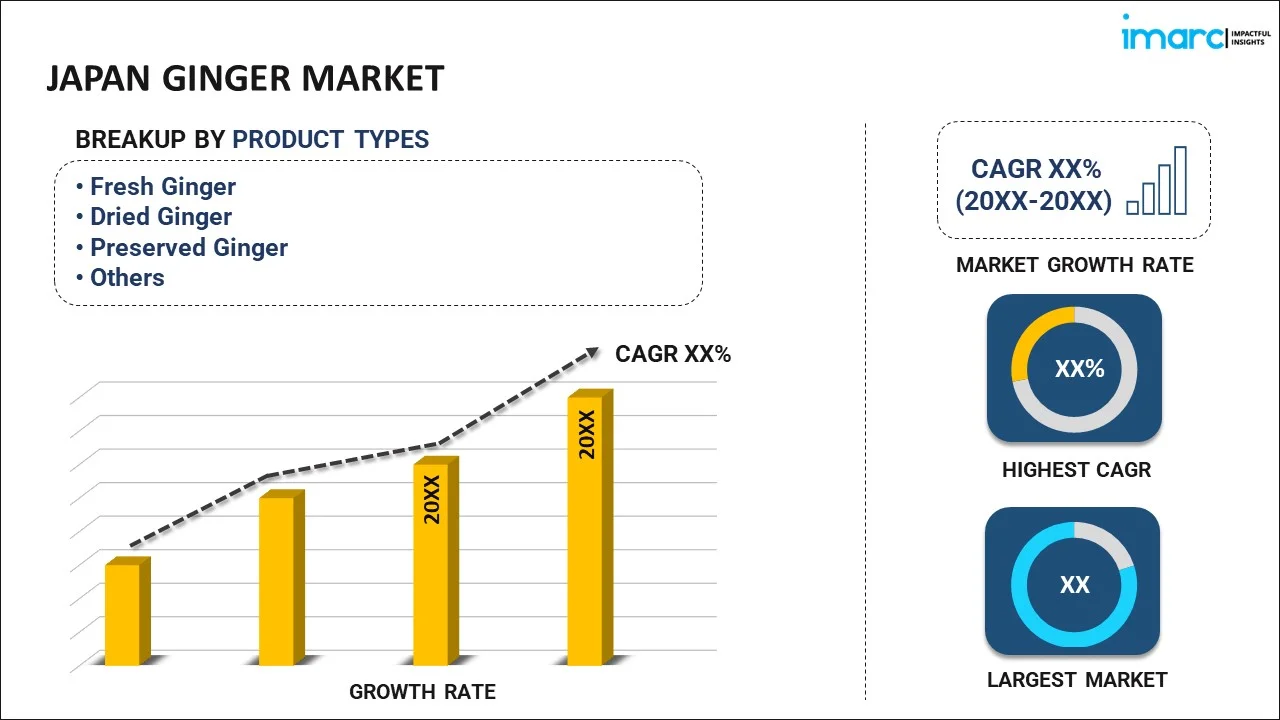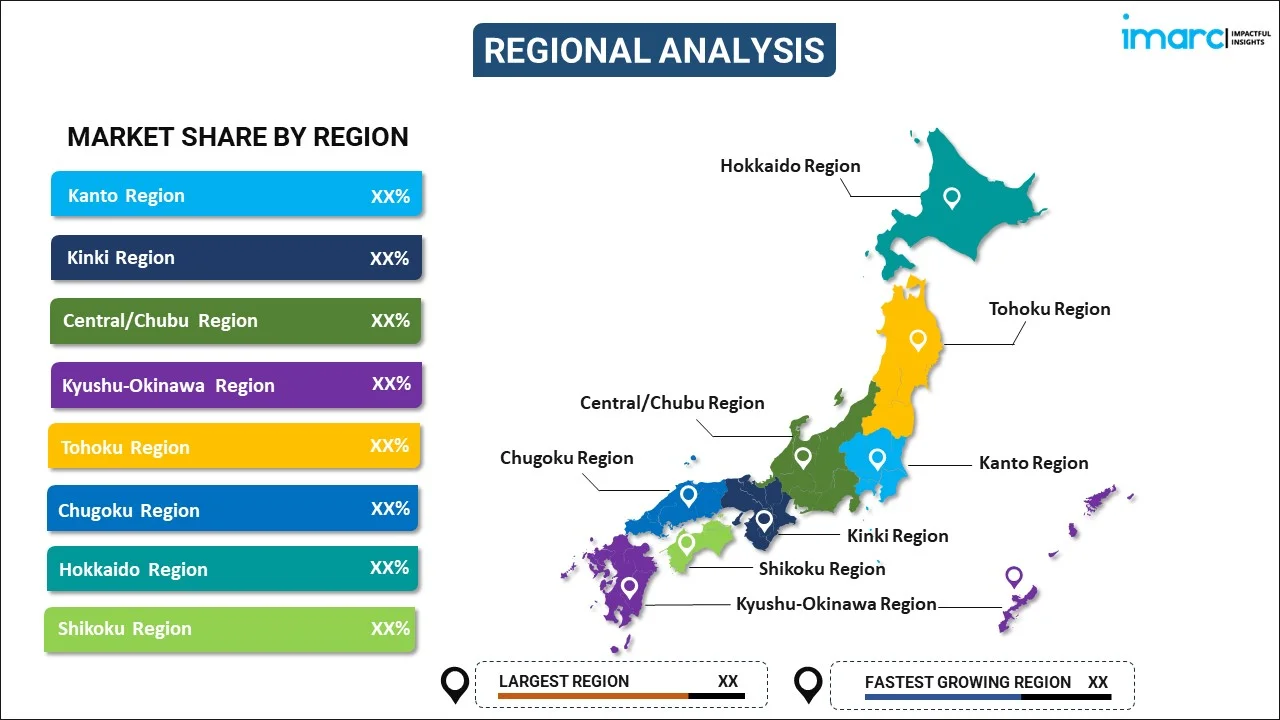
Japan Ginger Market Report by Product Type (Fresh Ginger, Dried Ginger, Preserved Ginger, Ginger Oil, and Others), Application (Food Industry, Pharmaceuticals Industry, Cosmetics Industry, and Others), Distribution Channel (Traditional Retail, Modern Retail Stores, and Others), and Region 2025-2033
Market Overview:
The Japan ginger market size reached USD 200 Million in 2024. Looking forward, IMARC Group expects the market to reach USD 490 Million by 2033, exhibiting a growth rate (CAGR) of 10.4% during 2025-2033. The growing recognition of the health benefits of ginger, extensive product usage in traditional Japanese cuisine, the rising product incorporation the production of cosmetics and personal care products, and easy product availability in offline and online organized retail channels represent some of the key factors driving the market.
|
Report Attribute
|
Key Statistics
|
|---|---|
|
Base Year
|
2024 |
|
Forecast Years
|
2025-2033
|
|
Historical Years
|
2019-2024
|
| Market Size in 2024 | USD 200 Million |
| Market Forecast in 2033 | USD 490 Million |
| Market Growth Rate (2025-2033) | 10.4% |
Ginger, scientifically known as Zingiber officinale, is a versatile plant rooted in both culinary applications and therapeutic traditions. This plant is characterized by an underground stem structure, commonly referred to as the rhizome or root that is esteemed for its distinctive, inviting aroma and hot, piquant flavor. The root, known as ginger, is a key ingredient in many Asian cuisines and is employed globally as a flavoring agent. In addition to its culinary uses, it's utilized for its medicinal qualities. It is abundantly packed with antioxidants, which are known to counteract harmful free radicals in the body. Furthermore, it harbors potent anti-inflammatory compounds, making it an effective natural remedy for various inflammatory conditions. The functionality of ginger is rooted in its active component, gingerol. This chemical compound delivers the root's well-known pungent taste and is also responsible for its anti-nausea, digestive health, and anti-inflammatory attributes. From the potent taste that invigorates the culinary landscape to the wellness benefits influencing human health, ginger has multifaceted uses that span across various sectors.
Japan Ginger Market Trends:
The market in Japan is primarily driven by the growing recognition of the health benefits of ginger. This is strengthened by the escalating global health-conscious trend, with consumers increasingly adopting natural products. In line with this, the increasing awareness of the cultural significance of ginger resulting in extensive product usage in traditional Japanese cuisine is resulting in a higher product uptake in a wide range of local dishes. Moreover, the burgeoning popularity of ginger-based beverages, particularly ginger tea and ale, among Japanese consumers due to their refreshing taste and perceived health benefits is fueling the market. In addition to this, the rising product incorporation in the production of cosmetics and personal care products due to its potential anti-aging properties is creating lucrative opportunities in the market. Also, the escalating demand for ginger oil in aromatherapy along with the thriving wellness industry is acting as another significant growth-inducing factor for the market. The market is further driven by the easy product availability in offline retail channels as well as the rapid expansion of e-commerce platforms for the sale of fresh produce. Furthermore, continual technological advancements in agricultural practices leading to improvements in yield and quality of ginger are further fueling the market. Apart from this, the growing adoption of urban farming in Japan has contributed to the local production of ginger, thus providing an impetus to the market. Some of the other factors contributing to the market include the increasing use of ginger in formulating pharmaceuticals and nutraceuticals, introduction of innovative ginger-infused food products and beverages by major manufacturers, and favorable government initiatives promoting the use of homegrown spices and herbs.
Japan Ginger Market Segmentation:
IMARC Group provides an analysis of the key trends in each segment of the Japan ginger market report, along with forecasts at the country level for 2025-2033. Our report has categorized the market based on product type, application, and distribution channel.
Product Type Insights:

- Fresh Ginger
- Dried Ginger
- Preserved Ginger
- Ginger Oil
- Others
The report has provided a detailed breakup and analysis of the market based on the product type. This includes fresh ginger, dried ginger, preserved ginger, ginger oil, and others.
Application Insights:
- Food Industry
- Pharmaceuticals Industry
- Cosmetics Industry
- Others
A detailed breakup and analysis of the market based on the application has also been provided in the report. This includes food industry, pharmaceuticals industry, cosmetics industry, and others.
Distribution Channel Insights:
- Traditional Retail
- Modern Retail Stores
- Others
A detailed breakup and analysis of the market based on the distribution channel has also been provided in the report. This includes traditional retail, modern retail stores, and others.
Regional Insights:

- Kanto Region
- Kinki Region
- Central/ Chubu Region
- Kyushu-Okinawa Region
- Tohoku Region
- Chugoku Region
- Hokkaido Region
- Shikoku Region
The report has also provided a comprehensive analysis of all the major regional markets, which include Kanto Region, Kinki Region, Central/ Chubu Region, Kyushu-Okinawa Region, Tohoku Region, Chugoku Region, Hokkaido Region, and Shikoku Region.
Competitive Landscape:
The report has also provided a comprehensive analysis of the competitive landscape in the market. Competitive analysis such as market structure, key player positioning, top winning strategies, competitive dashboard, and company evaluation quadrant has been covered in the report. Also, detailed profiles of all major companies have been provided.
Japan Ginger Market Report Coverage:
| Report Features | Details |
|---|---|
| Base Year of the Analysis | 2024 |
| Historical Period | 2019-2024 |
| Forecast Period | 2025-2033 |
| Units | Million USD |
| Scope of the Report | Exploration of Historical and Forecast Trends, Industry Catalysts and Challenges, Segment-Wise Historical and Predictive Market Assessment:
|
| Product Types Covered | Fresh Ginger, Dried Ginger, Preserved Ginger, Ginger Oil, Others |
| Applications Covered | Food Industry, Pharmaceuticals Industry, Cosmetics Industry, Others |
| Distribution Channels Covered | Traditional Retail, Modern Retail Stores, Others |
| Regions Covered | Kanto Region, Kinki Region, Central/ Chubu Region, Kyushu-Okinawa Region, Tohoku Region, Chugoku Region, Hokkaido Region, Shikoku Region |
| Customization Scope | 10% Free Customization |
| Post-Sale Analyst Support | 10-12 Weeks |
| Delivery Format | PDF and Excel through Email (We can also provide the editable version of the report in PPT/Word format on special request) |
Key Questions Answered in This Report:
- How has the Japan ginger market performed so far and how will it perform in the coming years?
- What has been the impact of COVID-19 on the Japan ginger market?
- What is the breakup of the Japan ginger market on the basis of product type?
- What is the breakup of the Japan ginger market on the basis of application?
- What is the breakup of the Japan ginger market on the basis of distribution channel?
- What are the various stages in the value chain of the Japan ginger market?
- What are the key driving factors and challenges in the Japan ginger market?
- What is the structure of the Japan ginger market and who are the key players?
- What is the degree of competition in the Japan ginger market?
Key Benefits for Stakeholders:
- IMARC’s report offers a comprehensive quantitative analysis of various market segments, historical and current market trends, market forecasts, and dynamics of the Japan ginger market from 2019-2033.
- The research study provides the latest information on the market drivers, challenges, and opportunities in the Japan ginger market.
- Porter's five forces analysis assist stakeholders in assessing the impact of new entrants, competitive rivalry, supplier power, buyer power, and the threat of substitution. It helps stakeholders to analyze the level of competition within the Japan ginger industry and its attractiveness.
- Competitive landscape allows stakeholders to understand their competitive environment and provides an insight into the current positions of key players in the market.
Need more help?
- Speak to our experienced analysts for insights on the current market scenarios.
- Include additional segments and countries to customize the report as per your requirement.
- Gain an unparalleled competitive advantage in your domain by understanding how to utilize the report and positively impacting your operations and revenue.
- For further assistance, please connect with our analysts.
 Inquire Before Buying
Inquire Before Buying
 Speak to an Analyst
Speak to an Analyst
 Request Brochure
Request Brochure
 Request Customization
Request Customization




.webp)




.webp)












